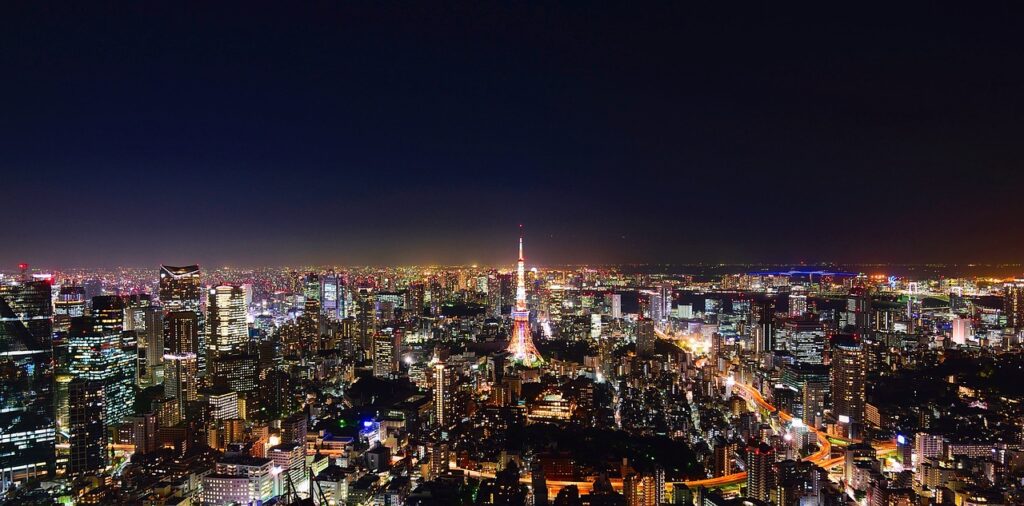BEST TIME TO VISIT TOKYO
Post Highlights
- 1 Introduction of Tokyo
- 2 Tokyo is Famous For
- 3 All the Nearby Places in Tokyo to Visit with Distance
- 4 Itinerary to Visit Tokyo and Nearby Places
- 5 How to Reach Tokyo
- 6 Best Hotels in Tokyo
- 7 Best Time to Visit Tokyo
- 8 Local Culture & Cuisine of Tokyo
- 9 Activities to Do in Tokyo
- 10 Tokyo Travel Budget for a Couple in Dollars and Local Currency
- 11 Tokyo Reviews of Travelers Positive and Negative
- 12 Traveling with Family or Solo to Tokyo
- 13 Travel Essentials
- 14 Important Instructions
- 15 Safety Travel Tips
- 16 Conclusion
Introduction of Tokyo
Best Time to Visit Tokyo, the vibrant capital of Japan, is a fascinating blend of modernity and tradition, making it an irresistible destination for travelers worldwide. This bustling metropolis offers a unique experience with its cutting-edge technology, historic temples, exquisite cuisine, and warm hospitality. In this guide, we will delve into the essence of Tokyo, covering everything you need to know for an unforgettable journey.
Tokyo is Famous For
Tokyo is renowned for its dynamic urban landscape, technological innovations, and rich cultural heritage. The city stands as a testament to Japan’s ability to seamlessly merge the traditional and the contemporary. From the towering skyscrapers of Shinjuku to the serene temples of Asakusa, Tokyo promises an immersive experience for every type of traveler.
All the Nearby Places in Tokyo to Visit with Distance
Tokyo is surrounded by captivating destinations, each offering a distinct flavor of Japanese culture and landscapes. Notable nearby places include:
1. Tokyo Tower

Tokyo Tower stands as an iconic landmark in the heart of the city, a symbol of Japan’s post-war rebirth and technological prowess. Soaring 333 meters into the sky, this lattice structure offers breathtaking panoramic views of Tokyo and beyond. Completed in 1958, it combines elements of Western architectural influence with traditional Japanese design, making it a unique fusion of cultures. Visitors can ascend to the observation decks to witness the cityscape illuminated against the backdrop of Mount Fuji, creating a truly mesmerizing experience.
2. Senso-ji Temple (Asakusa Kannon Temple)
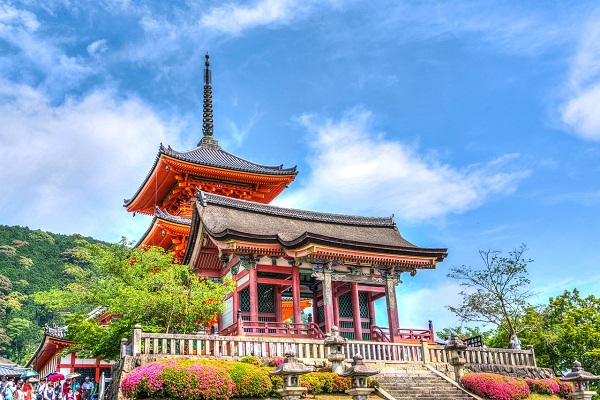
Situated in the historic district of Asakusa, Senso-ji Temple is Tokyo’s oldest and most revered Buddhist temple. Stepping through the Kaminarimon Gate, visitors are greeted by Nakamise-dori, a bustling shopping street leading to the temple’s main hall. The rich cultural tapestry of Senso-ji includes the famous Thunder Gate, the five-story pagoda, and the atmospheric Asakusa Shrine. Pilgrims and tourists alike flock to this spiritual haven, immersed in the serene ambiance and the vibrant energy of Asakusa.
3. Shibuya Crossing

Shibuya Crossing is the epitome of Tokyo’s frenetic energy and urban chaos. Located outside Shibuya Station, it’s renowned as the busiest pedestrian crossing in the world. As traffic halts in all directions, a surge of people floods the intersection, creating a mesmerizing spectacle of synchronized movement. The surrounding area is a vibrant hub of shopping, entertainment, and nightlife, with towering billboards and neon lights contributing to Shibuya’s dynamic atmosphere. The Hachiko Statue nearby pays tribute to the loyal dog, further enhancing the area’s cultural significance.
4. Meiji Shrine

Nestled within the lush expanse of Yoyogi Park, Meiji Shrine is a serene oasis that pays homage to Emperor Meiji and Empress Shoken. Stepping through the imposing Torii gate, visitors are transported into a world of tranquility, surrounded by towering cedar trees. The shrine’s main hall is a marvel of Shinto architecture, offering a peaceful retreat from the bustling city. Meiji Shrine is a popular destination for traditional Shinto weddings, and the vast courtyard hosts various festivals throughout the year, providing a glimpse into Japan’s rich cultural heritage.
5. Akihabara
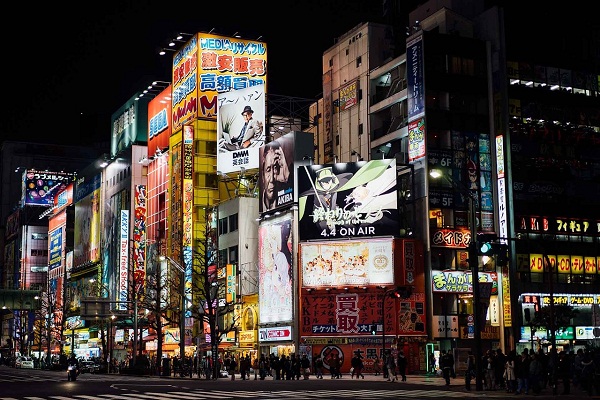
Akihabara, often referred to as the “Electric Town,” is a haven for tech enthusiasts, anime lovers, and gaming aficionados. Neon lights and vibrant billboards line the streets, advertising the latest gadgets, manga, and electronic goods. This district is a mecca for pop culture, hosting countless anime shops, manga cafes, and electronic stores. Akihabara’s unique charm lies in its ability to blend modern technology with the nostalgic allure of Japan’s pop culture, creating a vibrant and eclectic atmosphere that attracts enthusiasts from around the globe.
6. Tsukiji Outer Market
While the Tsukiji Fish Market has relocated to Toyosu, the Tsukiji Outer Market remains a culinary haven for seafood enthusiasts. This bustling market offers a diverse array of fresh seafood, sushi, and local delicacies. Visitors can sample the finest sushi crafted by skilled chefs or explore stalls selling traditional Japanese snacks. The lively ambiance, coupled with the enticing aromas of grilling seafood, makes Tsukiji Outer Market a must-visit destination for those seeking an authentic taste of Tokyo’s culinary treasures.
7. Ueno Park

Ueno Park is a vast green space in the heart of Tokyo, offering a serene escape from the urban hustle and bustle. Home to several museums, including the Tokyo National Museum and the Ueno Zoo, the park attracts visitors with its cherry blossoms in spring and vibrant foliage in autumn. The iconic Ueno Park provides a peaceful retreat for picnics, leisurely strolls, and cultural exploration. The Shinobazu Pond, surrounded by lotus flowers, adds to the park’s scenic beauty, making it a beloved destination for locals and tourists alike.
8. Tokyo Disneyland and DisneySea
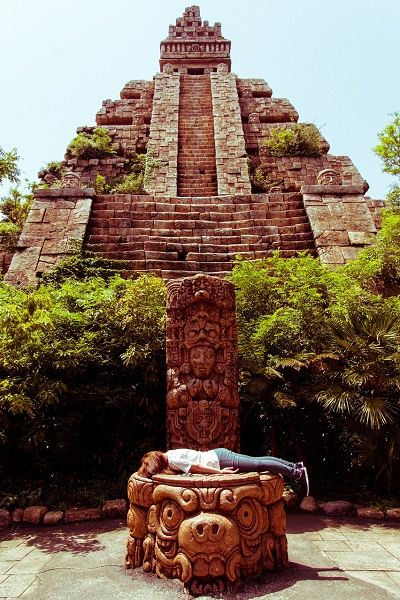
Located in Urayasu, just outside Tokyo, Tokyo Disneyland and DisneySea are enchanting theme parks that bring the magic of Disney to Japan. Tokyo Disneyland captures the classic charm of Disneyland, featuring iconic attractions, parades, and beloved Disney characters. On the other hand, DisneySea offers a unique maritime-themed experience with attractions inspired by different ports of call. The parks provide a magical escape for visitors of all ages, immersing them in a world of fantasy, entertainment, and whimsy.
9. Odaiba
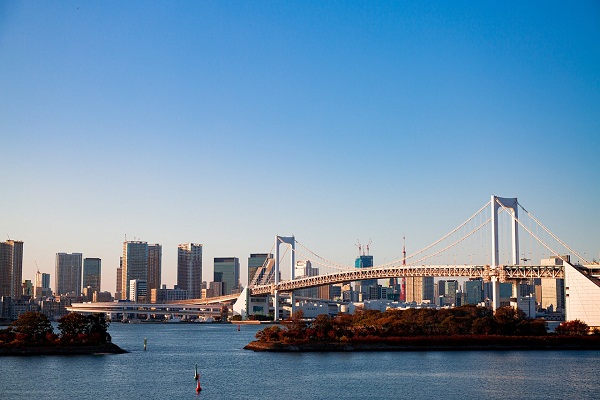
Odaiba is a futuristic entertainment and shopping district situated on a man-made island in Tokyo Bay. Boasting contemporary architecture, Odaiba offers a mix of attractions, including shopping malls, theme parks, and leisure complexes. The Rainbow Bridge connects Odaiba to the mainland, providing stunning views of Tokyo Bay. Popular destinations in Odaiba include Palette Town, Odaiba Seaside Park, and the teamLab Borderless digital art museum, creating a diverse and captivating experience for locals and tourists alike.
10. Roppongi Hills

Best Time to Visit Tokyo Roppongi Hills stands as a modern urban complex in the heart of Tokyo’s Roppongi district. This sophisticated development includes office spaces, luxury residences, shopping malls, and cultural institutions. Mori Art Museum, located within Roppongi Hills, showcases contemporary art from Japan and around the world. The Mori Tower’s observation deck offers breathtaking views of the city skyline. Roppongi Hills is not only a commercial and cultural hub but also a symbol of Tokyo’s dynamic and cosmopolitan spirit.
Itinerary to Visit Tokyo and Nearby Places
Planning a trip to the Best time to visit Tokyo and nearby places can be an exciting experience! Tokyo offers a blend of traditional and modern attractions, while the surrounding areas provide diverse experiences. Consider the following proposed schedule for a week-length excursion:
Day 1-3: Tokyo
Day 1: Explore Central Tokyo
- Morning: Start your day with a visit to the historic Asakusa district. Explore Senso-ji Temple and Nakamise Shopping Street.
- Afternoon: Head to the trendy Shibuya district. Visit Shibuya Crossing, Hachiko Statue, and explore the shopping and entertainment areas.
- Evening: Experience the vibrant nightlife in the Roppongi district.
Day 2: Modern Tokyo and Culture
- Morning: Visit the Tokyo Tower for panoramic views of the city.
- Afternoon: Explore the bustling district of Harajuku, known for its quirky fashion and Takeshita Street.
- Evening: Visit the Meiji Shrine and stroll through the peaceful Yoyogi Park.
Day 3: Tech and Shopping
- Morning: Explore the electronics haven Akihabara.
- Afternoon: Go shopping in Ginza, Tokyo’s upscale shopping district.
- Evening: Relax in Odaiba, an artificial island with entertainment complexes, shopping malls, and beautiful waterfront views.
Day 4: Day Trip to Nikko
- Take a day trip to Nikko, a UNESCO World Heritage site. Visit Toshogu Shrine, Lake Chuzenji, and Kegon Falls. Return to Tokyo in the evening.
Day 5: Day Trip to Hakone
- Explore Hakone, known for hot springs and scenic views of Mount Fuji. Visit Hakone Open-Air Museum, take a cruise on Lake Ashi, and soak in an onsen. Return to Tokyo in the evening.
Day 6: Day Trip to Yokohama
- Explore Yokohama’s waterfront, visit Landmark Tower, Chinatown, and Sankeien Garden. Enjoy the view from the Cosmo Clock 21. Return to Tokyo in the evening.
Day 7: Free Day or Explore Tokyo Further
- Spend your last day exploring any remaining Tokyo attractions or revisit your favorite spots.
- Optional: Visit Ueno Park, Tokyo National Museum, or explore the Tsukiji Outer Market.
Adjust the itinerary based on your interests and preferences. Remember to check the opening hours of attractions and transportation schedules. Enjoy your trip to Tokyo and its nearby treasures!
How to Reach Tokyo
Reaching Tokyo depends on your current location and mode of transportation. Here are some general guidelines:
- By Air:
- Tokyo has two major international airports: Narita International Airport (NRT) and Haneda International Airport (HND). Most international flights land at Narita, while Haneda serves both domestic and international flights.
- Check for direct flights to either Narita or Haneda from your departure city. Use online travel platforms or contact airlines for booking.
- By Train:
- If you are already in Japan or nearby regions, you can consider taking the Shinkansen (bullet train) to Tokyo. The Shinkansen network connects major cities in Japan efficiently.
- Tokyo has several train stations, including Tokyo Station and Shinjuku Station. Choose the station based on your location and preferences.
- By Bus:
- Long-distance buses connect various cities in Japan, and you may find overnight buses as a cost-effective option. Check bus schedules and routes with bus companies like Willer Express or other regional operators.
- By Car:
- If you prefer driving, you can rent a car and use highways to reach Tokyo. Stay informed about the traffic rules and regulations in your local area.
- By Sea:
- Tokyo has several ports, and you might consider arriving by cruise ship. Check with cruise companies for availability and schedules.
- Visa Requirements:
- Ensure you have the necessary visas and travel documentation before planning your trip. Japan’s visa requirements vary depending on your nationality and the purpose of your visit.
- Local Transportation:
- Once in Tokyo, the city has an extensive and efficient public transportation system, including trains and buses. Taxis are also readily available.
- Travel Planning:
- Use online travel agencies, airline websites, or consult with travel agents to plan your journey. Check for any travel restrictions, weather conditions, and other important information before departure.
Always check for the latest travel information and updates, especially considering any changes in regulations or conditions. Safe travels!
Best Hotels in Tokyo
Here are some popular hotels in Tokyo:
- Aman Tokyo: A luxury hotel located in the Otemachi financial district, offering stunning views of the city.
- Mandarin Oriental, Tokyo: Situated in the Nihonbashi area, known for its excellent service and panoramic views of Tokyo.
- The Ritz-Carlton, Tokyo: Located in the Roppongi district, this upscale hotel offers elegant accommodations and a high level of service.
- Park Hyatt Tokyo: Featured prominently in the movie “Lost in Translation,” this hotel is in the Shinjuku district and provides breathtaking views of the city.
- Four Seasons Hotel Tokyo at Marunouchi: A luxury hotel conveniently located near Tokyo Station, offering a sophisticated and comfortable experience.
- Hotel Chinzanso Tokyo: Set in a large garden in Bunkyo, this hotel provides a serene escape from the bustling city while still being centrally located.
- The Peninsula Tokyo: Situated in the upscale Marunouchi district, this hotel offers luxurious accommodations and excellent dining options.
- Andaz Tokyo Toranomon Hills: A stylish and contemporary hotel located in the Toranomon Hills complex, providing a modern and vibrant atmosphere.
- Conrad Tokyo: Overlooking Tokyo Bay, this hotel in the Shiodome area combines modern luxury with Japanese hospitality.
- Hotel Okura Tokyo: A classic and renowned hotel with a blend of tradition and modernity, located in the Toranomon district.
Best Time to Visit Tokyo
The Best time to visit Tokyo depends on your preferences and the type of experience you’re seeking. Tokyo experiences four distinct seasons, each offering a unique atmosphere. Here’s a general overview:
- Spring (March to May):
- Cherry Blossom Season: Spring is one of the most popular times to visit Tokyo due to the cherry blossoms (sakura). The exact timing varies each year, but late March to early April is typically the peak season. Parks like Ueno and Chidorigafuchi are famous for cherry blossom viewing.
- Summer (June to August):
- Tokyo experiences warm and humid summers. June sees the end of the rainy season, while July and August can be quite warm. This is also the typhoon season, so occasional heavy rains and storms are possible.
- Autumn (September to November):
- Autumn is another pleasant time to visit when temperatures are milder. The fall foliage, especially in parks like Meiji Jingu Gaien and Shinjuku Gyoen, is beautiful from late October to early December.
- Winter (December to February):
- Winters in Tokyo are relatively mild compared to some other parts of the world. While it rarely snows in the city, temperatures can drop, especially in January and February. Winter illuminations and holiday decorations can be charming.
Consider your personal preferences when planning your trip. If you enjoy festivals and the beauty of cherry blossoms, spring might be ideal. If you prefer milder temperatures and fall foliage, autumn is a great choice. Keep in mind that popular seasons, like cherry blossom season, can be crowded, so plan accordingly. Additionally, Tokyo is a vibrant city with events and activities happening year-round, so there’s always something to experience.
Local Culture & Cuisine of Tokyo
Best Time to Visit Tokyo, the capital city of Japan, is a vibrant and dynamic metropolis that blends modernity with tradition. The local culture and cuisine of Tokyo reflect the rich history and influences that have shaped the city over the centuries. Here are some key aspects of Tokyo’s culture and cuisine:
Culture:
- Traditional and Modern Architecture:
- Tokyo features a blend of both traditional and modern architectural styles. You can find historic temples and shrines alongside modern skyscrapers and innovative structures like the Tokyo Skytree.
- Fashion:
- Tokyo is a global fashion hub known for its unique street fashion and diverse style trends. Harajuku, Shibuya, and Shinjuku are popular districts for exploring the latest fashion trends.
- Anime and Manga:
- Tokyo serves as a paradise for those passionate about anime and manga. Akihabara is the epicenter of otaku (anime and manga fan) culture, with numerous specialty shops, themed cafes, and massive electronic stores.
- Ceremonial Tea Culture:
- Traditional tea ceremonies are still an integral part of Tokyo’s culture. You can experience this serene and refined ritual at tea houses and gardens like Hamarikyu Gardens.
- Cherry Blossom Festivals:
- During spring, Tokyo is adorned with cherry blossoms (sakura). Hanami parties, where people gather to appreciate the cherry blossoms, are a beloved tradition.
- Historical Museums:
- Tokyo has museums like the Edo-Tokyo Museum that showcase the city’s transformation from the Edo period to its current state.
Cuisine:
- Sushi and Sashimi:
- Tokyo is synonymous with fresh and high-quality sushi. Tsukiji Outer Market, despite the inner wholesale market moving, remains a fantastic place to sample various sushi and sashimi dishes.
- Ramen:
- Ramen shops are scattered across Tokyo, offering a variety of noodle soups with different broths and toppings. Each district may have its unique ramen style.
- Izakayas:
- These are traditional Japanese pubs where locals gather to enjoy drinks and small, flavorful dishes. Izakayas offer a casual and sociable dining experience.
- Tempura:
- Tokyo is home to excellent tempura restaurants, where ingredients like shrimp and vegetables are delicately coated in a light batter and deep-fried to perfection.
- Street Food:
- Street food stalls, especially in areas like Asakusa and Harajuku, offer a wide range of tasty treats such as takoyaki (octopus balls), taiyaki (fish-shaped cakes), and yakitori (grilled chicken skewers).
- Kaiseki Ryori:
- For a high-end dining experience, try kaiseki, a multi-course meal that highlights seasonal ingredients and traditional Japanese culinary techniques.
Tokyo’s culture and cuisine are a delightful blend of tradition and innovation, making it a fascinating destination for both locals and visitors alike.
Activities to Do in Tokyo
The best time to visit Tokyo has something for everyone. Explore the following activities as options for your visit:
- Explore Asakusa:
- Visit Senso-ji, Tokyo’s oldest temple.
- Wander through Nakamise Shopping Street for traditional souvenirs and snacks.
- Tsukiji Outer Market:
- Indulge in the exquisite flavors of fresh seafood and other regional delicacies.
- Attend a sushi-making class or enjoy a sushi breakfast.
- Shibuya Crossing and Hachiko Statue:
- Witness the famous Shibuya Crossing, one of the busiest intersections in the world.
- Pay homage to Hachiko, the loyal dog, by visiting his statue near Shibuya Station.
- Meiji Shrine and Yoyogi Park:
- Explore the serene Meiji Shrine surrounded by lush forest.
- Relax in Yoyogi Park, a popular spot for picnics and people-watching.
- Harajuku and Takeshita Street:
- Experience the unique and colorful fashion trends in Harajuku.
- Shop for trendy clothes, accessories, and try creative desserts.
- Akihabara – Electric Town:
- Immerse yourself in the world of electronics, anime, and manga.
- Visit themed cafes and shops dedicated to pop culture.
- Odaiba:
- Enjoy entertainment complexes like Palette Town and DiverCity Tokyo Plaza.
- Witness the impressive Rainbow Bridge and explore the Odaiba Seaside Park.
- Tokyo Tower and Tokyo Skytree:
- Admire panoramic views of the city from these iconic landmarks.
- Consider visiting during the evening for stunning nightscapes.
- Ueno Park and Museums:
- Stroll through Ueno Park and visit Ueno Zoo.
- Explore museums like the Tokyo National Museum and the National Museum of Western Art.
- Roppongi Hills:
- Experience upscale shopping, dining, and entertainment.
- Visit the Mori Art Museum for contemporary art exhibitions.
- Sumo Wrestling Experience:
- Attend a sumo wrestling match or watch a practice session.
- Discover the rich history and cultural traditions of sumo wrestling.
- Day Trip to Nikko or Hakone:
- Take a day trip to Nikko to explore historical shrines and natural beauty.
- Visit Hakone for hot springs, art museums, and views of Mt. Fuji.
- Culinary Adventures:
- Indulge in Japanese cuisine at local izakayas, ramen shops, and sushi restaurants.
- Try unique and seasonal dishes like kaiseki or okonomiyaki.
Remember that Tokyo is a city that seamlessly blends tradition and modernity, offering a diverse range of experiences for every type of traveler.
Tokyo Travel Budget for a Couple in Dollars and Local Currency
On average, a mid-range budget for a couple in Tokyo is around $200-$300 per day, covering accommodation, meals, transportation, and activities. In local currency (Japanese Yen), this translates to approximately ¥22,000 to ¥33,000.
Tokyo Reviews of Travelers Positive and Negative
Positive reviews often highlight Tokyo’s cleanliness, efficiency, and the blend of modern and traditional attractions. Some negative aspects may include language barriers and crowded public transportation during rush hours.
Traveling with Family or Solo to Tokyo
Best time to visitTokyo is suitable for both family vacations and solo adventures. Families can enjoy theme parks like Tokyo Disneyland, while solo travelers may appreciate the city’s vibrant nightlife and cultural experiences.
Travel Essentials
- Japan Rail Pass: Ideal for exploring nearby cities.
- Pocket Wi-Fi: Stay connected with portable internet.
- Suica or Pasmo Card: Convenient for seamless public transportation.
- Comfortable Shoes: Expect lots of walking.
- Universal Power Adapter: Japan uses a unique socket type.
Important Instructions
- Etiquette: Respect local customs, including bowing and removing shoes in certain places.
- Language: Learn a few basic Japanese phrases or use translation apps.
- Cash: Many places prefer cash, so carry sufficient yen.
- Transportation Passes: Purchase transportation passes for convenience.
Safety Travel Tips
- Low Crime Rates: Tokyo is generally safe, with low crime rates.
- Natural Disasters: Be aware of earthquake safety measures.
- Lost and Found: Japan’s lost and found system is highly efficient.
Conclusion
Tokyo is a mesmerizing destination that seamlessly integrates tradition and modernity. Whether you’re captivated by the neon lights of Shibuya, the tranquility of ancient temples, or the flavors of local cuisine, Tokyo offers a diverse range of experiences for every traveler. Plan your journey wisely, and let Tokyo unfold its wonders in a way that resonates with your interests and preferences.

